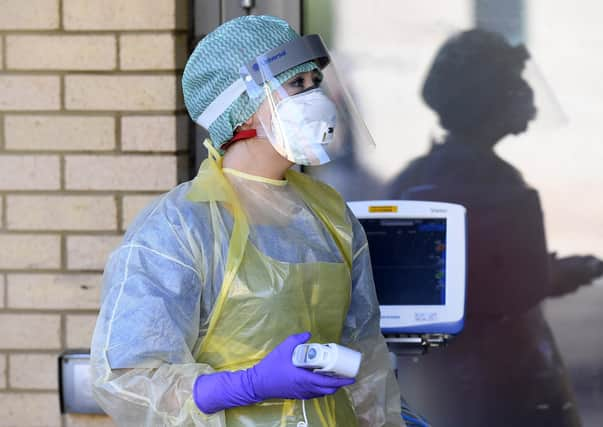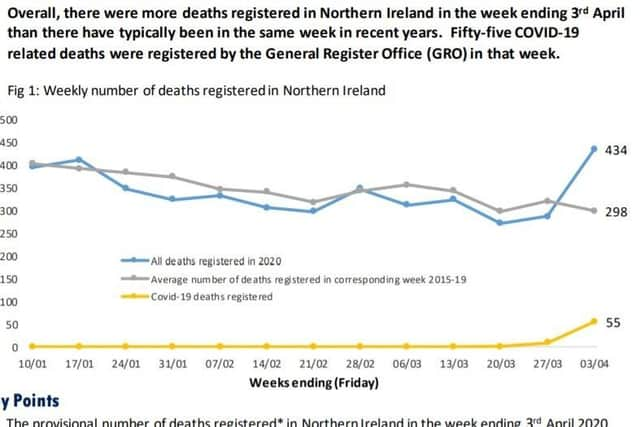New figures could be true reflection of Covid-19 impact on NI


According to the latest verified figures from the NI Statistics and Research Agency (NISRA), while the Public Health Authority’s daily updates recorded 35 Covid-19 deaths in one week, the week-on-week overall mortality rate in NI had rocketed by 147 deaths.
The latest statistics available cover the week up to April 3. That week there were 434 deaths recorded, compared to 287 the week before. The five-year average figure is 298 deaths.
Advertisement
Hide AdAdvertisement
Hide AdAs of yesterday, the number of confirmed Covid-19 fatalities stands at 124, however, this figure only includes those patients who died in a hospital setting – and does not include residents of nursing and care homes.


Pressure has been building on the Department of Health to increase testing to establish the true figure. The first Covid-19 death registed in Northern Ireland was on March 18.
On Monday, a new report from the International Long-Term Care Policy Network said that data from five European countries “suggest that care home residents have so far accounted for between 42% and 57% of all deaths related to Covid-19”.
The report states: “Very few countries appear to be testing people in care homes (staff and residents) systematically. This makes it very difficult to estimate the numbers of people with Covid-19 infections and also to count how many care home residents and staff have died as a result of infection. Given this lack of consistent testing, it appears that the best way to estimate the mortality impact of Covid-19 in care homes will be by comparing mortality data from the period of the pandemic to mortality in previous years at the same time of the year.”
Advertisement
Hide AdAdvertisement
Hide AdDr Alan Stout, chair of the BMA NI GP committee, told the News Letter that with only limited testing being carried out, “the number of reported deaths has always lagged behind the true number and therefore it is not possible to have an accurate picture of how many people have had, currently have or have died from Covid-19”.
Dr Stout added: “In order to have a clear picture of how Covid-19 is spreading there needs to be two things – an increase in testing to include not only those admitted to hospital but those in the community as well and a shift in the way deaths are recorded so it includes cases in the community where Covid is the most likely cause of death. This would give us a more accurate picture of how the disease is spreading and would help us to target resources more effectively.
“In terms of fatalities if we have as clear a picture as possible of who had died it will help us see patterns in terms of who is most susceptible to Covid-19 and we can then develop and tailor appropriate prevention and treatment pathways.”
Explaining the discrepancy between the PHA running totals and the NISRA numbers, NISRA state that it own figures “have to be certified by a doctor, registered and processed – but once ready...are the most complete statistical information”.
Advertisement
Hide AdAdvertisement
Hide AdEarlier this month, the World Health Organisation (WHO) said it could be difficult to “tease out” accurate figures on the true Covid-19 death rate, after a key UK expert said up to 67% of deaths might have happened this year anyway due to advanced age and other serious illnesses.
A spokesperson for the PHA said the daily bulletin figures are “valuable” as they give a good indication of what is happening day by day, but said: “They won’t necessarily include all deaths involving Covid-19”.
They added: “While it may be that some of the deaths occurring in Northern Ireland...during this time may have also been related to Covid-19, it would be inappropriate to speculate what any other causes of death may have been until official reports are complete”.
NISRA states that its own figures “have to be certified by a doctor, registered and processed – but once ready...are the most complete statistical information”.
• A message from the Editor:
Advertisement
Hide AdAdvertisement
Hide AdThank you for reading this story on our website. While I have your attention, I also have an important request to make of you.
With the coronavirus lockdown having a major impact on many of our advertisers - and consequently the revenue we receive - we are more reliant than ever on you taking out a digital subscription.
Subscribe to newsletter.co.uk and enjoy unlimited access to the best Northern Ireland and UK news and information online and on our app. With a digital subscription, you can read more than 5 articles, see fewer ads, enjoy faster load times, and get access to exclusive newsletters and content. Visit https://www.newsletter.co.uk/subscriptions now to sign up.
Our journalism costs money and we rely on advertising, print and digital revenues to help to support them. By supporting us, we are able to support you in providing trusted, fact-checked content for this website.
Alistair Bushe
Editor